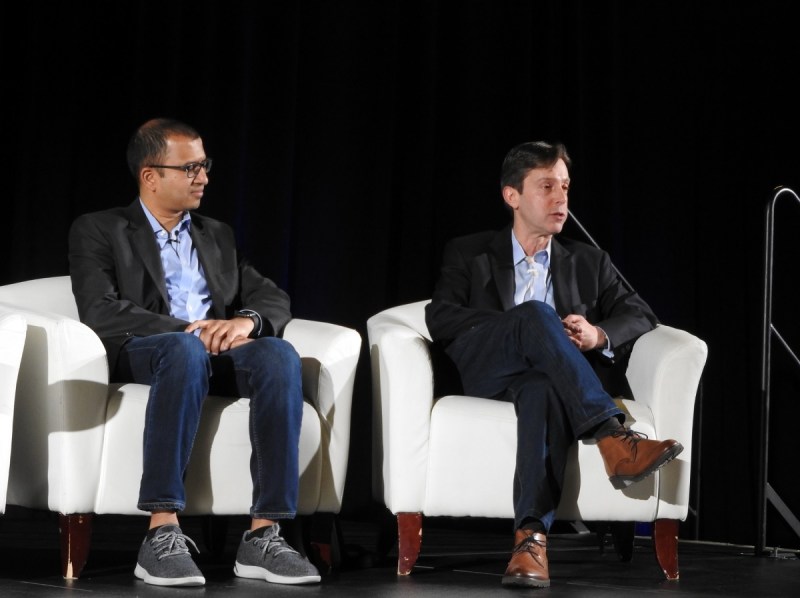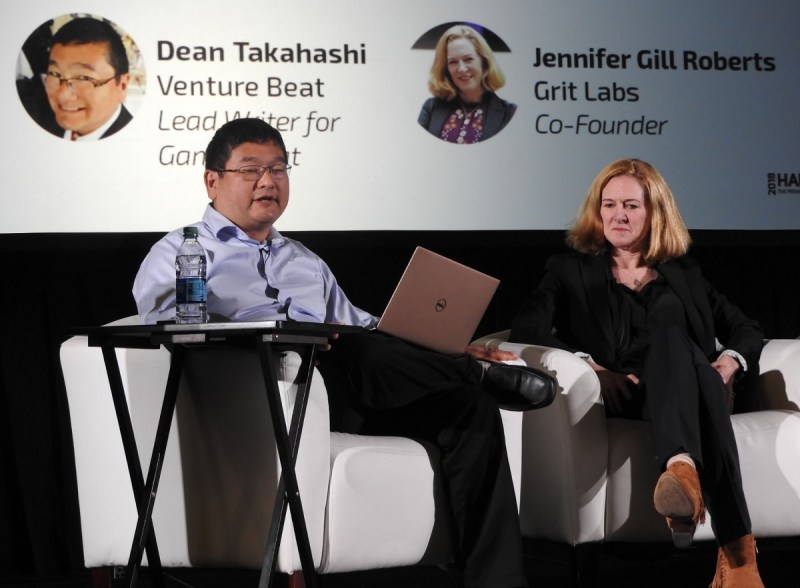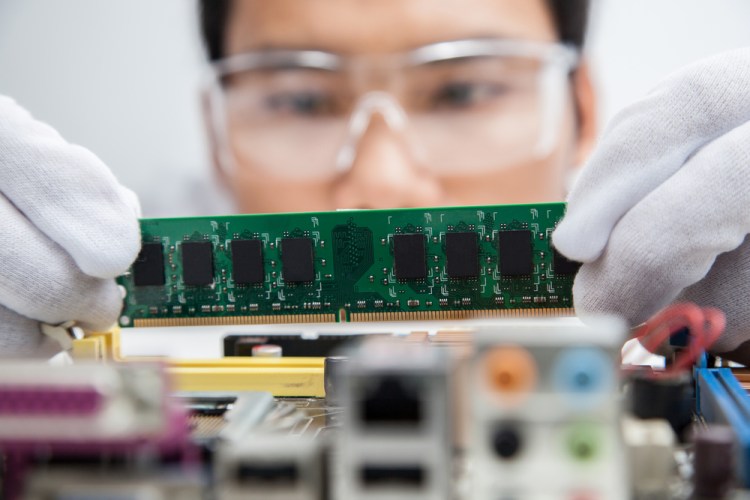
Above: Ashish Aggarwal, principal at Grishin Robotics and Eph Lindenbaum, managing director, Advance Ventures, at HardwareCon.
VentureBeat: What sort of guidance do you give in some of these areas? It seems like we have enough self-driving car startups. Nvidia’s working with 400 different companies doing something with its self-driving car chips. Nvidia’s also said their working with 2,900 AI companies, engaging with them in some way. You start to think, these guys are all ahead already. Should I do what they’re doing?
Lindenbaum: Let me throw this out there. One of the hottest bubbles right now is connected scooters. This didn’t take machine vision or robotics or anything else. This took a problem with a good hardware solution. This is less of a solution looking for a problem. We see a lot of that in these categories, where it’s not clear where the exit trajectory is in the near term.
This is one of the greatest times in the history of entrepreneurship to start a company. This is also the greatest place on the planet to start a company. There are incubators. There are accelerators. There are micro-funds. There’s AngelList. There’s crowdfunding. On this panel, everything from smaller funds and angels all the way up to big boys. I saw an entrepreneur recently who was basically gaming the accelerator and incubator system. Who had the best food? Who had the best package? These programs were competing for a startup.
As an entrepreneur looking for funding, you have all the standard stuff we talk about. How do you point the ship? How do you look out into the future and figure something out? But it really comes down to the product. Great companies solve problems. A great VC, a firm president once said to me once, “The shorter the deck, the better the product.” I asked him what was the shortest deck he ever funded. He said, “Three slides. If I could get one that was down to one I would fund it in a heartbeat.”
June 5th: The AI Audit in NYC
Join us next week in NYC to engage with top executive leaders, delving into strategies for auditing AI models to ensure fairness, optimal performance, and ethical compliance across diverse organizations. Secure your attendance for this exclusive invite-only event.
This is all about solving big problems. With what we look at, we break it into two categories. There’s the brave new world, and there’s better, faster, cheaper. It’s a question of picking one and going after it. With all of the infrastructure that’s now available to you, as well as the ability to manufacture quickly—as I was talking about earlier, M&A has become a big part of R&D. The ability to get out there and get enough traction under your startup to get our interest is incredibly high.
It’s all about solving a real problem. It can be as complex as robots or as simple as scooters. Don’t get wrapped around the axle trying to make something too complex. Just solve a big problem.
VentureBeat: Are you getting to the distinction between a maker or an inventor and an entrepreneur, who’s actually got a shot at getting funding?
Edelhart: One thing to keep in mind, as we bring this back to how you get funding: are you actually a company? Or are you a product attribute? We’ve got something really wizard that’s nobody’s ever done before that solves part of the problem. It contributes. But is it doing something big? Is it part of something else? Is it just a product?
If there’s a deficiency in the companies we see, it’s the lack of recognition that business model innovation produces much more value than technological innovation. Technological innovation on its own is great, but how does it make a company? Microsoft became Microsoft because it was on every computer. It had a distribution advantage. As that went away, the company had to work much harder to succeed.
You have to think about solving a big problem in a way that actually produces a company. You have to build value not just in an interesting product or an interesting set of capabilities. That involves distribution, understanding who the customers are and how you get to them, and how you can use all of that to create real value with a real organization and real people.

Above: Dean Takahashi and Jennifer Gill Roberts at HardwareCon.
Roberts: I wanted to comment a bit on fundraising, because I’ve been in those shoes as well. I had a startup, and I probably pitched 200 investors, micro-VCs, and venture firms. With our own portfolio, we go out with them and help them raise and try to make sure they go through that pre-seed through seed through A. It’s really hard, and there’s a few things to think about.
First of all, incubators sound great, but when they take a lot of your common equity and your cap table gets screwed up, that’s something you need to think through. A lot of investors are passive in that seed to A phase that we see. They literally have a thousand in their spreadsheet. You’re not going to get a lot of help during that time frame. You’ll need to be smart about who you surround yourself with, advisors who can help you think through business models and launch. They’re probably barely going to respond to your calls.
Knowing what their fund size is and how they think about outcomes is important. A $30 million fund versus a billion-dollar fund is a very different profile of success. That whole process deserves an immense amount of hard work, as well as strategy, so you’re not wasting your time beating on doors that just aren’t going to fund you or that aren’t interested in the space you’re in. It’s a repeat exercise I do with every portfolio company.
Lindenbaum: I want to go back to something that Mike said. If you walk away with nothing but that critical data point, we’re going to save you lots of pain and suffering and time. Are you building a startup? You can come see all of us in the Valley, but if the venture economics don’t work—I don’t want to go into a deep dive on venture economics, but there are specific benchmarks you need to see in companies in order for them to work. The differential between a venture-scale company and a great company is often very different.
It’s really important to look out into the future of what you’re working with today. Is this a venture company? We’ll have to go through a number of baseline checkoffs in order to even bring you into consideration within our firm. That’s an important aspect of this. Don’t break your back seeing 200 of us if the fundamentals aren’t there. Is this company going to reach a multi-hundred-million-dollar exit in a reasonable time frame? Is the adoption curve of the technology within our life cycle? Venture funds are 10 years. If you’re going to exit in 10 years and a day, you just scored a touchdown five minutes after the game’s over. It doesn’t matter to us.
You have to look inward and understand things beyond the personal. Is this a venture product? Does this have a real exit trajectory with a meaningful return that’s going to click with our level of interest? That’s important. There are lots of great companies out there that have been able to get funded and everything else, but don’t go into this often difficult ecosystem and spend a lot of cycles if it doesn’t match up early on.
We saw this in mobile. Was it an app or was it a company? We’re seeing a lot of this in hardware today. Is it a solution or, as Mike said, a part of a solution? Or is it a company? Those are the most important factors to look at. If you take that away, that’s going to save you time and effort. It’s not always right to build a venture company. There are lots of good companies that do get venture funding, but understanding that differential is really a time-saver for an entrepreneur.
VentureBeat: I wanted to get to a lesson a company has taught you, that could be valuable for the audience. I’m thinking of the movie Founder, about McDonald’s. Ray Kroc was grinding away, trying to get his franchises going, trying to make a royalty from the hamburgers they sold. Another guy came in and says to him, “You haven’t figured out what business you’re in. You think you’re in the hamburger business, but you really should be in the real estate business. You can make more money buying land and leasing it to your franchises.” I wonder if you have some lessons like that apply to hardware.
Edelhart: At the topmost level, it’s too much belief and too little belief. The one thing I’ll say, after doing this for a long time, I don’t think I’ve ever seen a startup that ever succeeded doing exactly what they said they were going to when they walked in with a deck. Life just doesn’t work that way. Companies have to adjust with what the market teaches them, what technology turns out to make possible in a practical way or not.
Companies that come in where the CEO says, “I’m right. I’ve always been right. I’ve never been wrong. Everything I say is true,” that company’s going to get in trouble, because that hardly ever happens. Companies who come in and—this is absolutely what not to say in a meeting, at least with a venture capitalist like me. “What do you think we ought to do?” I don’t know! I’m spending 45 minutes on your company. You’re supposed to be spending 22 hours a day.
So we find that companies with too much belief and too little belief, in their different ways, they get into the weeds. Success comes from the capacity, from the top down, to always believe – the company always knows what it’s about – and always change. What it’s about is different from what it was six months ago.
You have a big dream. You have a big problem. But you’re acting small right now. You have to get a customer, then 10 customers. You have to get 10,000 units and then 100,000 units. If you’re focused on taking over Europe, but you can’t manufacture at your current scale, you’re not taking over anything. It’s that juxtaposition. I had someone in a meeting, an entrepreneur, say to me recently, “You have to have a plan, and if it’s more than a one-year plan, you’re fooling yourself.” It’s a 12-week plan, an eight-week plan, maybe a three-week plan. The event horizon you can actually control in your business is not far off.

Above: The Nvidia Shield microconsole with remote and gamepad.
Aggarwal: People forget how easy hardware is to copy. You’ll be surprised. Other companies can do it better, faster, cheaper, at a point where you can’t imagine. People get hung up on thinking, “No, the hardware I built cannot be copied.” Understand that you have to really build the prestige factors around the software layer, or some other way that cannot be copied. That’s extremely important.
If you’re building hardware for consumers, the market is already so big. You’re competing against some of the biggest players – Google, Apple, Amazon. It’s a very covered market. Also, from what we’ve seen, looking at companies that have been successful, only a handful have been successful in the hardware space, at least on the consumer side. By studying those, you can try not to make the same mistakes.
Going after a market that already exists and trying to sell in that market—for example, in the case of Ring, everybody has a doorbell. The high line is, can you make a product that makes life a little bit better for you as the owner of that product? How frequently do people actually buy this product? What is the pain point it’s going to solve? Understanding all these fundamental questions and being able to be very scrappy, early on, trying to do these things—this matters a lot, even for hardware startups.
When we see a hardware startup that’s raised a lot of capital and they haven’t launched a product, that’s a very big red flag. Where have you put all that money? They’re saying, “Well, we were trying to perfect the technology.” The other side of the spectrum, like on the China side—Chinese entrepreneurs are very good at executing. Even the low-tech solutions. A good example of that is Amazon Go-style stores. In China there are already companies that have deployed hundreds of these stores at scale. If you search for companies like BingoBox, they already exist. Over here people are still trying to perfect the technology to make sure it works.
Understanding the market you’re going after, there’s a lot you can achieve. That’s something I tell people. Try to build a product in a market that already exists, so you’re not the first that’s spending millions of dollars educating people about why they should buy your product.
Lindenbaum: I don’t necessarily buy into the idea that every company pivots, because if you look at the big ones — Facebook, Google, Apple — they didn’t. They are all what they started as, for the most part. That true sense of being able to get there makes sense. Although the pivot is clearly a big part of the model. But really, finding a big problem and solving it is still the crux of our whole business.
That problem may be one step beyond the surface level. Our belief in Ring, for example, is if you didn’t have packages, then people wouldn’t have been as interested in doing that. It’s not only the first step. It’s really the second step. If you look at why they were acquired, it’s because there’s a pretty long tail associated with that concept.
Look at the problems that are solvable. People are jammed up in San Francisco. Somebody connected a scooter. Now they’re duking it out for control of the city. Taxicabs are inefficient. Now we have ride-sharing. Look at problems. Don’t look at technology and then go try and solve something that may or may not be a true problem. The bigger the problem, the easier it is to break it down. The smaller the problem, the bigger the problem you have.
Edelhart: You can have your Jerry Springer moment. I’ll point out, for the record, that the first version of Facebook was about pretty girls on the Harvard campus—
Lindenbaum: What do you think people are using Facebook for now? I don’t know what you’re using it for.
Edelhart: You couldn’t even get in if you weren’t a college student.
Lindenbaum: That’s called denial marketing.
Roberts: I’d also like to inject a little controversy. I am not excited about businesses where the hardware is the centerpiece. I’d encourage you all to think about—your team is probably going to need to be 80 percent AI. Hardware is off the shelf.
We’ve talked about this, but it’s about identifying those big customer problems. Rigorously go after understanding them, the human-centered design approach. Have those really differentiated teams, because they bring the deep domain knowledge. They bring the different disciplines. They understand that they’re building a service. They have to be customer-centric, not PhDs meeting with customers. I can’t even imagine funding a hardware business today like I used to where it was all about developing hardware. It’s just not going to be the case anymore.


